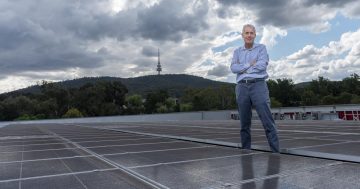
The Shine Dome’s roof is made up of 1888 handmade copper tiles. Photo: Australian Academy of Science Twitter.
When the Shine Dome was formed in the mind of architect Roy Grounds, he wanted it to be a portrait of how he saw the scientists who would work within: “full of mystery, romance and intense intellectual exercises, at the same time.”
Hammered by hailstones during the January 2020 storm, those scientists and their unique collections had to leave their specially built home.
But now, the Dome has officially been restored to its former glory.
Australian Academy of Science President Professor Chennupati Jagadish described the enormity of the damage: “The violence of the hail left the copper roof peppered and, most worryingly, all the glass skylights smashed, leaving some of the unique scientific collections exposed to the elements.
“Academy staff carried hundreds of boxes to a safe space and saved the collections.”
Once the damage was assessed, Professor Jagadish said the entire copper roof needed re-cladding.
“For several months, we gained a direct insight into some of the challenges that must have been faced by those who constructed the Dome in 1958,” he said.
“Options 1, 2, 3, 4, and 5 were all considered and then torn up.”
Finally, a solution was discovered: the original copper would be kept and a new copper layer placed over the top.
The 1888 new copper tiles needed to be custom-made and individually laid, with ARC Roofing and architect firm Erin Martin and Associates brought in to complete the job.
Additionally, each tile would be dedicated to an Australian scientist or team of scientists who have contributed significantly to their field or to a school teacher who has made an impact on a scientist’s career.
Not only did the storm cause the Dome’s roof to be repaired, Professor Jagadish said it also pushed the academy into action over its physical collections.
“The hailstorm was a timely reminder that the digitisation of our scientific collections really could not wait any longer,” he said.
The Shine Dome was officially re-opened, with Governor-General David Hurley helping usher in its next chapter.
He said seeing how the structure had endured and recovered from the damage gave him a sense of “confidence and optimism” about the future.
“That may sound like an odd or even glib statement to make [but] it is informed by, in part, my observations of the Australian character and the capacity of Australians to tackle and solve big problems,” General Hurley said.
“Academy Fellows have dedicated their careers to science, humanity, and solving the world’s challenges and creating new opportunities.
“That’s what fuels my optimism about the future.”
General Hurley noted the Australian Academy of Science had had a “remarkable” couple of years, despite the disruption to its workplace.
“It has helped improve Australians’ understanding of the benefits of immunisation. It has published a climate report on the risks to Australia of a warming world … it has launched a STEM Women database to raise the profile of women in STEM,” he said.
“These are significant achievements; there are many others.”
He described the building as a “special place” and thanked those who worked within its walls.
“Its architecture and design inspires and befits those who make a unique and valuable contribution to humanity. Yet its power comes from within – from its people.”
Adding shine to the Dome
The foundation stone for the Shine Dome was laid in 1958 by then-Prime Minister Robert Menzies and was described as “unconventional and futuristic” at its opening in 1959.
“Many doubted that a 720-tonne concrete dome balanced on 16 slender supports could indeed stand,” Professor Jagadish said.
It was built because the new Australian Academy of Science needed a home.
It was originally called Becker House, but became known as the Shine Dome when it was renovated in 2001, which was made possible by past president Professor John Shine who donated some of the proceeds from his scientific discoveries to fund the works.
The Dome has been known by many names, including the Martian Embassy, the Igloo and the Mushroom.

A time capsule was placed in the top of the Dome as the roof was being restored. Photo: Australia Academy of Science.
The building was added to the National Heritage List in 2005 as it “is believed to be the only true example in the country of Geometric Structuralism, an architectural movement which used tension to maximise the function of the structure.”
The Dome has witnessed a number of scientific breakthroughs, including from Professor Suzanne Cory, whose work in molecular biology changed lymphoma treatment, and Professor Eddie Holmes, whose studies in virology helped guide Australia through the COVID-19 pandemic.
The Shine Dome also houses many historic scientific collections, including the diaries of Professor Frank Fenner, who declared to the World Health Organisation that smallpox had been eradicated.
Twenty-two of his notebooks were digitised earlier this year, and they can be accessed via the Academy of Science’s website and the National Library’s Trove database.
As the copper roof was being replaced in mid-2021, a time capsule containing messages from the Fellows of the Academy was placed inside to be discovered by future scientists that will call the building home.



















